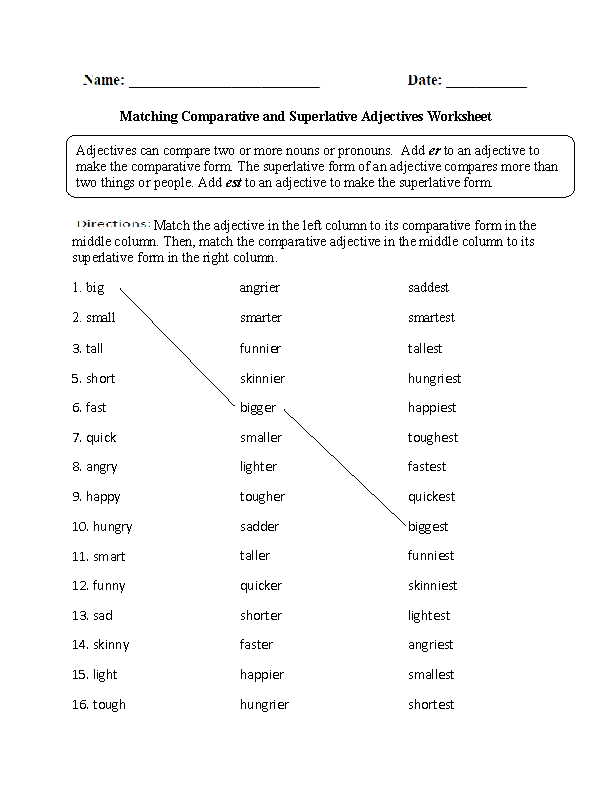
Understanding and Practicing Comparative and Superlative Adjectives
September 7th, 2024
00:00

00:00
Summary
- Importance of adjectives in English
- Comparing nouns or pronouns with adjectives
- Forming comparative and superlative adjectives
- Practical exercises for students
- Matching adjectives to their forms
- Rewriting sentences with correct forms
- Sentence completion exercises
- Educational value for middle school students
Sources
Adjectives play a crucial role in the English language, serving as descriptive words that modify nouns or pronouns. They provide specificity and detail, which can enhance both writing and speaking skills. Understanding how to effectively use adjectives can significantly improve communication by making expressions more vivid and precise. One key function of adjectives is their ability to compare two or more nouns or pronouns. This comparative aspect is fundamental for conveying differences or similarities in various contexts. For instance, when describing the height of two buildings, one might say, The first building is taller than the second. Here, the adjective tall is modified to its comparative form taller to compare the two buildings. Moving beyond simple comparisons, adjectives can also express the highest degree of a quality among three or more nouns or pronouns. This is where superlative adjectives come into play. For example, in the sentence, She is the tallest student in the class, the adjective tall is modified to its superlative form tallest to indicate that she surpasses all other students in height. The formation of comparative and superlative adjectives typically follows regular rules. To create the comparative form, one generally adds er to the base adjective. For example, fast becomes faster. To form the superlative, est is added, transforming fast into fastest. These modifications are straightforward and follow a predictable pattern, making them relatively easy to learn and apply. Understanding these forms is essential for students, particularly those in grades six through eight. Various worksheets are available to practice these skills, such as matching adjectives to their comparative and superlative forms, rewriting sentences using the correct forms, and completing sentences with the appropriate adjective forms. These exercises help solidify the rules and enhance the learners ability to use comparative and superlative adjectives accurately in both writing and speaking contexts. By mastering these concepts, learners can significantly improve their descriptive capabilities, making their communication more effective and engaging. Practical exercises are a vital tool for mastering the use of comparative and superlative adjectives. These exercises not only reinforce the rules for forming these adjectives but also provide students with the opportunity to apply their knowledge in various contexts. One such exercise is the Matching Comparative and Superlative Adjectives Worksheet. This activity requires students to match an adjective in the left column to its comparative form in the middle column and then connect the comparative form to its superlative form in the right column. For example, students might see the adjective happy in the left column, and they would then match it to happier in the middle column and happiest in the right column. This type of exercise helps students to internalize the spelling changes and endings that form these comparative and superlative adjectives. Another useful tool is the Comparative and Superlative Adjectives Practice Worksheet. In this exercise, students are asked to rewrite sentences using the comparative or superlative form of adjectives provided in parentheses. For instance, given the sentence This book is (interesting) than that one, students would rewrite it as This book is more interesting than that one. This practice not only reinforces the correct forms but also helps students understand how to use these adjectives in real-world sentences. Additionally, the States Comparative and Superlative Adjectives Worksheet provides an exercise where students must complete sentences with the appropriate form of an adjective. For example, a prompt might read, Of the three brothers, Tom is the (tall), and students would fill in the blank with tallest to complete the sentence correctly. This type of exercise encourages students to think about the context in which the adjectives are used and choose the correct form accordingly. These worksheets are particularly beneficial for students in 6th, 7th, and 8th grades. At this educational level, building a strong foundation in grammar can significantly enhance a students writing and speaking abilities. By engaging with these practical exercises, students not only learn the rules governing comparative and superlative adjectives but also gain experience using them in a variety of sentences and contexts. This hands-on practice is crucial for solidifying their understanding and improving their overall language skills.